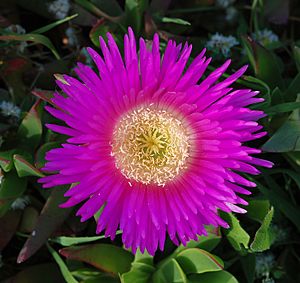Sea fig facts for kids
Quick facts for kids Sea fig |
|
|---|---|
 |
|
| Scientific classification | |
| Genus: |
Carpobrotus
|
| Species: |
chilensis
|
| Synonyms | |
|
Mesembryanthemum chilense |
|
The sea fig (scientific name: Carpobrotus chilensis) is a type of succulent plant. This means it has thick, fleshy parts that store water. You can often find it growing on sandy beaches and cliffs along the coast. People sometimes plant it in their gardens because it looks pretty. It's also a plant that you can eat!
However, the sea fig and its close relative, the "ice plant" (C. edulis), have spread a lot in places like the California coast. They can take over areas and push out the plants that naturally grow there. Because of this, people sometimes try to control where they grow.
Contents
What Does the Sea Fig Look Like?
The sea fig has long stems that spread out along the ground. These stems can grow over 2 meters (about 6.5 feet) long! They can even root into the soil as they spread, covering large areas like a carpet.
Its leaves are thick and fleshy, shaped like triangles, and are about 4 to 7.5 centimeters (1.5 to 3 inches) long.
The sea fig looks a lot like its cousin, the "ice plant" (Carpobrotus edulis). Sometimes, they even grow next to each other. But there are ways to tell them apart! The ice plant is usually bigger. Its flowers are also larger, about 2.5 to 6 inches (6 to 15 cm) across, and are yellow or light pink. The sea fig's flowers are smaller, about 1.5 to 2.5 inches (4 to 6 cm) across, and are a bright, deep pink or magenta color.
Sea fig flowers open in the morning and close up at night. This plant can bloom and grow fruit all year long. Its fruit has 8 to 10 small sections inside.
It's very easy to grow new sea fig plants. You can simply cut a piece of the stem and plant it in the soil. It will usually grow roots without needing any special help!
Where Does the Sea Fig Grow?
The sea fig usually grows in places with warm weather, like warm temperate and subtropical areas. It probably first came from southern Africa.
But now, you can find it in many other places around the world. It's very common along the coast of western North America, where it was brought by people and has spread widely. You can also find it growing naturally in countries like Argentina, Chile, Peru, Ecuador, Australia, Spain, Greece, southern England, and New Zealand.
This plant loves sunny spots. It usually grows on coastal sand dunes, cliffs, and along roadsides near the ocean. It can be found from sea level up to about 100 meters (330 feet) high along the Pacific Coast of North America.
Why Is the Sea Fig a Problem?
The sea fig can grow very well even in poor, sandy soil. It's also a tough plant that can handle being disturbed by people, which often happens on busy beaches where it grows.
These traits give it an advantage over many plants that naturally belong in these coastal areas. Because it's so hardy and spreads easily, it can take over habitats. This makes it a threat to the native plants and ecosystems where it has invaded.
How Can We Use the Sea Fig?
The sea fig plant has a pleasant taste. However, if you eat a lot of it, especially the fruit, it might upset your stomach.
You can eat the plant raw or cooked, especially its leaves. People also dry it for later use or make it into pickles and chutney. The fruit has only a small amount of soft flesh inside. It needs to be fully ripe, or it will taste very sour. The leaves can be added to salads or used as a replacement for pickled cucumbers.
Medicinal Uses
The juice from the sea fig leaves can be a bit sharp and has a mild antiseptic quality, which means it can help stop germs.
- For Upset Stomachs: You can mix the leaf juice with water to help with diarrhoea, dysentery, and stomach cramps.
- For Sore Throats: It can be used as a gargle to help with laryngitis, sore throats, and mouth infections. Chewing on the tip of a leaf and swallowing the juice might also help a sore throat.
- For Skin Problems: The leaf juice can be used on your skin to help soothe burns, bruises, scrapes, cuts, and sunburn. It's also used for skin conditions like ringworm, eczema, dermatitis, herpes, nappy rash, cold sores, chapped lips, chafing, and skin allergies. It can even help with insect stings.
See also
 In Spanish: Doca de Chile para niños
In Spanish: Doca de Chile para niños


